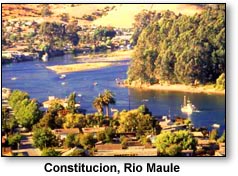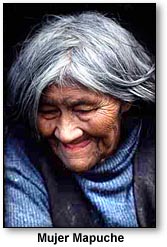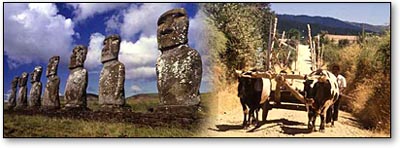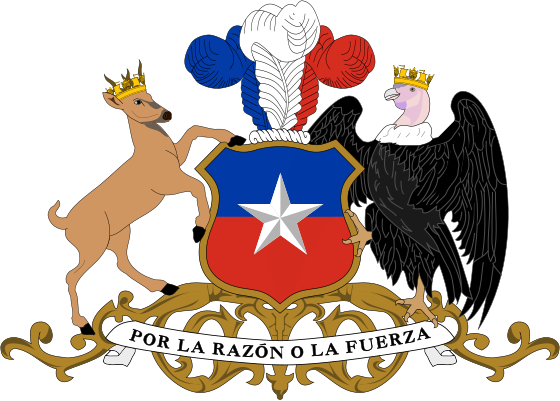               

|
Surrounded on three sides by virtually impassable barriers, Chile's rich central valley remained largely unknown to the outside world until the middle of the fifteenth century, when the Incas began their great conquests of much of the continent. Under Tupac Yupanqui, an Inca army succeeded in crossing the six hundred mile string of salt basins that are the Atacama Desert, moving from oasis to oasis in a region so dry that some parts of it show no evidence of ever having been rained upon. After coming at last into the central valley, the Incas encountered the Mapuche, one of the three Araucanian peoples who occupied the region.
 The invading army seemed at first to be enjoying the same success that the Incas were experiencing all over South America, and they advanced about half way down the valley's five hundred mile length. However, the Incas soon found that they had met their match in the Mapuche, who decisively defeated the Incan attempt to cross over the Rio Maule into the Lake District. The Incas established a stable presence in the territory they had gained, but they did not see fit to pursue the redoubtable Mapuche any further. The invading army seemed at first to be enjoying the same success that the Incas were experiencing all over South America, and they advanced about half way down the valley's five hundred mile length. However, the Incas soon found that they had met their match in the Mapuche, who decisively defeated the Incan attempt to cross over the Rio Maule into the Lake District. The Incas established a stable presence in the territory they had gained, but they did not see fit to pursue the redoubtable Mapuche any further.
Less than a century later, a Spanish army attempted to do just that. In 1541, Pedro de Valdavia crossed into the central valley, having followed the Inca road south from Peru. He founded Santiago in February, and soon afterward crossed into Mapuche domains and established strongholds there. In 1553, in a gesture no doubt familiar to the Spaniard Valdavia, they bound him to a tree and beheaded him.
For the next four hundred years the Spanish, like the Incas before them, found it appropriate to maintain a massive defensive presence in the central valley. During these centuries the regions under Spanish control were permitted to trade directly with Peru: smuggling flourished, and privateers swarmed along the coasts.
Chile gained its independence from Spain in 1817, after seven years of warfare. The Mapuche region to the south, which had remained largely independent of Spanish rule, also resisted the new Chilean government. Capable of marshalling full cavalry forces and even modern artillery, the Mapuche succeeded in holding onto their autonomy until the middle of the century, when large numbers of armed settlers gradually moved into the region.
Although Chile's war of independence brought into place a system of representative democracy, the country's political history has not always been smooth. In 1970, a Marxist government under Dr. Salvador Allende came to power, having responded to the perceived failure of the established liberal party. Allende's attempts to radically change the structure and direction of the country brought about a second political crisis however, and in 1973 a right-wing government under General Augusto Pinochet Ugarte seized power with assistance from the United States Central Intelligence Agency. Allende was killed in the coup, and Pinochet's government maintained power for the next
decade and a half, frequently resorting to terror in order to stifle discontent. In 1990, having failed in his bid to gain popular ratification for his rule, Pinochet handed over the presidency to the rightfully- elected Patricio Aylwin Azocar. Chile's political climate has since remained stable, although there is still considerable tension between the military and the government concerning the human rights violations of the Pinochet era.
 Chile's population is composed predominantly of mestizos, who are descended from marriage between the Spanish colonizers and the indigenous people. The surviving indigenous groups consist of the Aymara, in the north, and the Mapuche, who number roughly 100,000 and continue to inhabit the forested areas of the lake district. Chile is also home to a number of significant immigrant groups, including minority populations from virtually every European country. There are signifcant numbers of Basques and Palestinians. The high proportion of mestizos among Chile's people has made race a minor issue in comparison to class, which continues to be a source of considerable tension. The great majority of Chile's people, as one might expect, are concentrated in the central valley. Spanish is the country's official language, but some of the Indian dialects remain. In the north, they speak Aymara, in the south Mapuche, and on Easter Island the Polynesian language of Rapa Nui. Chile's population is composed predominantly of mestizos, who are descended from marriage between the Spanish colonizers and the indigenous people. The surviving indigenous groups consist of the Aymara, in the north, and the Mapuche, who number roughly 100,000 and continue to inhabit the forested areas of the lake district. Chile is also home to a number of significant immigrant groups, including minority populations from virtually every European country. There are signifcant numbers of Basques and Palestinians. The high proportion of mestizos among Chile's people has made race a minor issue in comparison to class, which continues to be a source of considerable tension. The great majority of Chile's people, as one might expect, are concentrated in the central valley. Spanish is the country's official language, but some of the Indian dialects remain. In the north, they speak Aymara, in the south Mapuche, and on Easter Island the Polynesian language of Rapa Nui.
copyright (c) 1998 - 2010 interKnowledge Corp. All rights reserved.

. |
|
|








